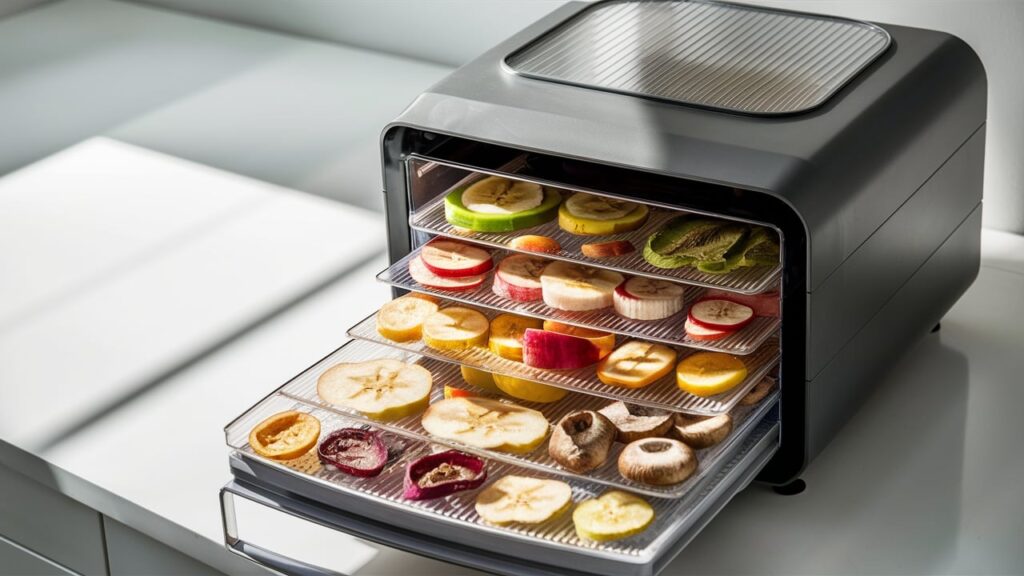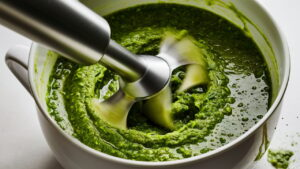Food dehydrators work by removing moisture from food using low heat and air circulation. A fan circulates warm air, facilitating moisture evaporation without cooking the food.
Recommended Best Food Dehydrators 2025
| Recommendation | Product |
| Best Overall | COSORI Food Dehydrator |
| Popular Choice | Excalibur Electric Food Dehydrator Machine |
| Best Value | Cercker Food-Dehydrator Machine |
| Best Budget | Magic Mill Food Dehydrator Machine |
| Another Excellent Pick | Hamilton Beach Digital Food Dehydrator |
Food dehydrators are essential kitchen appliances for anyone interested in preserving food. They efficiently extend shelf life by removing moisture, which prevents spoilage and bacterial growth. This method maintains the nutritional value of fruits, vegetables, and herbs, offering a healthy alternative to processed snacks.
Dehydrating food concentrates flavors, making it an excellent choice for those who enjoy intense tastes. These devices are user-friendly and can process various items, from meats to fruits, providing versatility in food preservation. Understanding how these machines operate can help you make the most of your food storage and encourage healthier eating habits.
Introduction To Food Dehydration
Food dehydration is a method that removes moisture from food. This process helps to preserve food for a longer time. Dehydrators use low heat and circulating air to achieve this. The removal of moisture prevents the growth of bacteria and other microorganisms.
Historically, dehydration dates back to ancient cultures. People dried fruits and meats to store them for winter. Today, food dehydrators are widely used for home preservation. They offer a convenient way to make healthy snacks without added sugars.
Modern dehydrators are efficient and easy to use. They allow for the preservation of a variety of foods. These include fruits, vegetables, and even herbs. The result is tasty snacks that are rich in nutrients and flavor.
Dehydrator Design And Components
A food dehydrator consists of several key components that work together. The heating element raises the temperature inside the unit. This helps in the removal of moisture from the food. A fan circulates warm air evenly across the trays. This process ensures that all pieces dry at the same rate.
Different variants of food dehydrators are available. Stackable models are compact and easy to store. They allow for flexible drying space. Shelf models are larger and offer more trays. These are ideal for drying larger quantities of food.
Commercial dehydrators have high capacity and power. They often come with advanced features. Some include temperature controls and timers for better precision.
The Science Behind Dehydration
The science behind food dehydration involves heat and air flow dynamics. A dehydrator uses low heat to remove moisture without cooking the food. The heating element raises the temperature inside the machine. A fan circulates this hot air, ensuring even moisture removal.
As warm air flows, it absorbs moisture from the food. The moisture removal process occurs when air passes over the food, taking away water vapor. This process continues until the food is dry. Maintaining the right temperature is crucial for effective dehydration.
| Factors | Effects on Dehydration |
|---|---|
| Temperature | Higher temperatures speed up moisture removal. |
| Airflow | Good airflow ensures even drying. |
| Humidity | Lower humidity levels enhance the drying process. |
Types Of Food Dehydrators
Food dehydrators come in various types. Stackable tray dehydrators consist of trays stacked on top of each other. They are often compact and easy to store. Shelf dehydrators have shelves that slide in and out, providing more space for larger batches. Both types offer effective moisture removal.
Electric dehydrators use electricity to heat air and circulate it around the food. They provide consistent results and can operate in any weather. On the other hand, solar dehydrators utilize sunlight for drying food. They are eco-friendly but depend on sunny conditions.
| Type | Advantages | Disadvantages |
|---|---|---|
| Stackable Tray | Compact, easy to store | Limited space for larger items |
| Shelf | More space for drying | Bulkier, harder to store |
| Electric | Consistent results, any weather | Higher energy use |
| Solar | Eco-friendly, low cost | Weather-dependent, slower process |
Benefits Of Dehydrating Food
Dehydrating food offers numerous benefits that enhance nutrition and flavor. This process helps retain vital nutrients while concentrating the food’s natural flavors. Dehydrated foods often taste richer and more intense.
Another significant advantage is the extended shelf life of dehydrated foods. Without moisture, bacteria and mold have a harder time growing. Storing these foods becomes easier and more efficient. They require less space and can be kept for months or even years.
Overall, using a food dehydrator allows you to enjoy healthy snacks anytime. It promotes a more sustainable and flavorful way to preserve your favorite fruits, vegetables, and meats.
Operating A Food Dehydrator
Operating a food dehydrator is simple and fun. First, prepare your food by washing and cutting it into uniform pieces. This helps ensure even drying. Next, arrange the pieces on the trays without overlapping. This allows air to flow freely around the food.
Set your dehydrator to the correct temperature based on the food type. For fruits, a range of 135°F to 145°F works well. Vegetables typically require 125°F to 135°F. Adjust the timing according to the moisture level desired. Fruits may take 6 to 12 hours, while vegetables usually take 4 to 10 hours.
| Food Type | Temperature (°F) | Time (Hours) |
|---|---|---|
| Fruits | 135 – 145 | 6 – 12 |
| Vegetables | 125 – 135 | 4 – 10 |
Creative Uses For Dehydrated Foods
Dehydrated foods offer many healthy snacking options. They are low in calories and high in nutrients. Enjoy dried fruits like apricots and mangoes for a sweet treat. Vegetable chips made from kale or beets provide a crunchy alternative to regular chips.
Using dehydrated foods for ingredient preparation is simple and efficient. Add dried herbs to soups and sauces for extra flavor. Use dehydrated vegetables in casseroles or stir-fries to save time. They can also be blended into powders for seasoning.
Snack mixes can include nuts, seeds, and dried fruits for a balanced treat. Dehydrated foods are perfect for hiking or camping since they are lightweight and easy to pack.

Potential Drawbacks Of Dehydration
Dehydrating food can lead to nutritional losses. Some vitamins, especially vitamin C and certain B vitamins, may decrease significantly. This loss can affect overall health benefits.
The texture of dehydrated food often changes. Foods can become chewy or crunchy, which might not appeal to everyone. This change can alter the way dishes taste and feel.
Rehydration also poses challenges. Dehydrated foods usually take longer to rehydrate compared to freeze-dried options. This can be inconvenient for quick meals.
Maintenance And Safety Tips
Food dehydrators use low heat and a fan to circulate air, effectively removing moisture from fruits, vegetables, and meats. This process preserves food while retaining its nutrients and flavor. Proper maintenance ensures safety and efficiency, making dehydrators a valuable kitchen tool for healthy snacking.
Cleaning And Upkeep
Regular cleaning of your food dehydrator is essential. Remove food residues after each use. Use a soft cloth and mild detergent to wipe surfaces. Avoid harsh chemicals that can damage the unit. Ensure all trays are cleaned thoroughly. Let them dry completely before storing. This keeps bacteria away and maintains hygiene.
Safe Dehydration Practices
Always follow guidelines for safe dehydration. Use only fresh and high-quality produce. Cut fruits and vegetables into uniform pieces for even drying. Check the dehydrator’s temperature settings to avoid under-dehydration. Properly store dehydrated foods in airtight containers. This prevents moisture from getting in and keeps them fresh.
Choosing The Right Dehydrator For You
Choosing the right dehydrator involves several key factors. First, consider the capacity. Larger models can handle more food. Next, look at temperature control. Adjustable settings allow for better results. The design also matters; a stackable design saves space.
Noise level is important too. Some dehydrators can be quite loud. Check for ease of cleaning as well. Removable trays make this task simpler. Finally, read customer reviews to find reliable brands and models.
| Brand | Model | Features |
|---|---|---|
| Excalibur | 3926TB | Adjustable thermostat, 9 trays |
| Nesco | FD-75A | 5 trays, top-mounted fan |
| Presto | 06300 | Easy to use, 4 trays |
Frequently Asked Questions
What Are The Disadvantages Of Dehydrating Food?
Dehydrating food has several disadvantages. Nutritional loss occurs, especially with certain vitamins. Texture changes may make foods chewy or overly crunchy. Rehydration often takes longer than with freeze-dried options. Lastly, flavor intensity can diminish, affecting overall taste.
How Does A Food Dehydrator Machine Work?
A food dehydrator works by using low heat and a fan to circulate air. This process removes moisture from food without cooking it. The result is shelf-stable products that retain flavor and nutrients. Dehydrators are efficient for preserving fruits, vegetables, and meats.
Are Food Dehydrators A Good Idea?
Food dehydrators are a great idea for preserving nutrients without additives. They create healthy snacks by removing moisture, enhancing flavors naturally. Dehydrated foods are lightweight and long-lasting, making them ideal for storage and travel. Overall, they offer a convenient way to enjoy nutritious, homemade snacks.
How Does Dehydration Of Food Work?
Food dehydration removes moisture to prevent spoilage. It uses low heat and airflow to dry food, preserving nutrients and flavor. This process reduces weight and volume, making storage easier. Dehydrated foods can last longer while maintaining their taste and nutritional value.
Conclusion
Understanding how food dehydrators work opens up a world of culinary possibilities. These devices efficiently remove moisture, preserving flavors and nutrients. With a range of applications, from making snacks to storing ingredients, they are a valuable addition to any kitchen.
Embrace the art of dehydration and enjoy healthier, longer-lasting foods.








